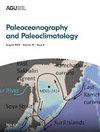Seismic Stratigraphy of Contourite Drift Deposits Associated With the Loop Current on the Eastern Campeche Bank, Gulf of Mexico
IF 3.2
2区 地球科学
Q2 GEOSCIENCES, MULTIDISCIPLINARY
引用次数: 0
Abstract
The Loop Current is a key component of global circulation via the northward transport of warm, salty water, and an important influence on Gulf of Mexico hydrography. Understanding how the Loop Current will respond to ongoing anthropogenic warming is critically important, but the history of the Loop Current is poorly known. Here, we present the results of a high resolution (3–8 m) multichannel seismic survey of pelagic carbonate sediment drifts on the eastern Campeche Bank associated with the Loop Current. We identify three seismic megasequences: Megasequence A is a Lower Cretaceous carbonate platform, Megasequence B comprises Cretaceous to lower Cenozoic pelagic carbonates with weak/no contour current flow, and Megasequence C comprises a series of large (100s of m thick) contourite drifts representing the inception and history of the Loop Current. The base of the contourites is marked by a regionally mappable unconformity eroding underling strata, sometimes incising hundreds of meters. The drifts contain a succession of sequence sets separated from each other by regional unconformities and comprising plastered drifts and massive mounded drifts, which characterize modern deposition with active moats on the seafloor. A lack of sediment cores in the study area precludes age determination of these drifts, except for the youngest (Late Pleistocene). Comparison to legacy seismic lines across Deep Sea Drilling Project Site 95, outside our study area, implies that the base of Megasequence C is Oligocene in age, and that the Loop Current developed during the global reorganization of ocean circulation around the Eocene‐Oligocene Transition.墨西哥湾东坎佩切河岸与环流有关的等高线漂移沉积的地震地层学研究
环流通过向北输送暖咸水而成为全球环流的关键组成部分,对墨西哥湾的水文地理具有重要影响。了解环流如何应对持续的人为变暖至关重要,但对环流的历史却知之甚少。在此,我们展示了对与环流相关的坎佩切岸东部浮游碳酸盐沉积漂移进行的高分辨率(3-8 米)多道地震勘测的结果。我们确定了三个地震大序列:巨序列 A 是下白垩统碳酸盐平台,巨序列 B 由白垩统至下新生代的浮游碳酸盐组成,具有微弱/无等高线海流,巨序列 C 由一系列大型(100 多米厚)等高线岩漂移组成,代表了环流的起源和历史。等高线岩的底部有一个区域性的、可测绘的、侵蚀下伏地层的不整合层,有时侵蚀达数百米。漂流包含一系列序列组,这些序列组之间被区域性的不整合所分隔,包括石膏漂流和巨大的堆积漂流,这是现代沉积的特征,海底有活跃的护城河。由于研究区域缺乏沉积岩芯,因此无法确定这些漂移的年龄,但最年轻的漂移(晚更新世)除外。与我们研究区域之外的深海钻探项目第 95 号地点的遗留地震测线进行比较后发现,巨序列 C 的基底为渐新世,环流是在始新世-渐新世过渡时期的全球海洋环流重组过程中形成的。
本文章由计算机程序翻译,如有差异,请以英文原文为准。
求助全文
约1分钟内获得全文
求助全文
来源期刊

Paleoceanography and Paleoclimatology
Earth and Planetary Sciences-Atmospheric Science
CiteScore
6.20
自引率
11.40%
发文量
107
期刊介绍:
Paleoceanography and Paleoclimatology (PALO) publishes papers dealing with records of past environments, biota and climate. Understanding of the Earth system as it was in the past requires the employment of a wide range of approaches including marine and lacustrine sedimentology and speleothems; ice sheet formation and flow; stable isotope, trace element, and organic geochemistry; paleontology and molecular paleontology; evolutionary processes; mineralization in organisms; understanding tree-ring formation; seismic stratigraphy; physical, chemical, and biological oceanography; geochemical, climate and earth system modeling, and many others. The scope of this journal is regional to global, rather than local, and includes studies of any geologic age (Precambrian to Quaternary, including modern analogs). Within this framework, papers on the following topics are to be included: chronology, stratigraphy (where relevant to correlation of paleoceanographic events), paleoreconstructions, paleoceanographic modeling, paleocirculation (deep, intermediate, and shallow), paleoclimatology (e.g., paleowinds and cryosphere history), global sediment and geochemical cycles, anoxia, sea level changes and effects, relations between biotic evolution and paleoceanography, biotic crises, paleobiology (e.g., ecology of “microfossils” used in paleoceanography), techniques and approaches in paleoceanographic inferences, and modern paleoceanographic analogs, and quantitative and integrative analysis of coupled ocean-atmosphere-biosphere processes. Paleoceanographic and Paleoclimate studies enable us to use the past in order to gain information on possible future climatic and biotic developments: the past is the key to the future, just as much and maybe more than the present is the key to the past.
 求助内容:
求助内容: 应助结果提醒方式:
应助结果提醒方式:


